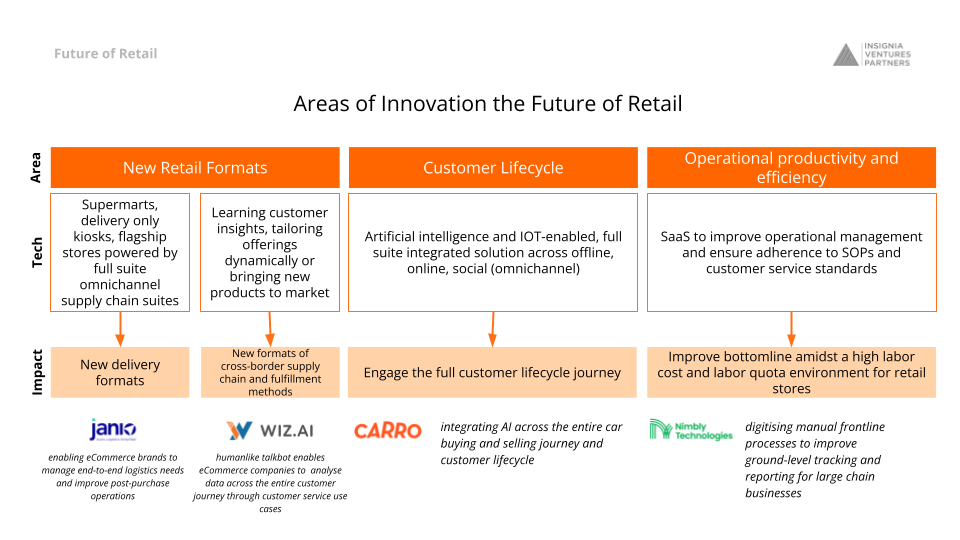Our VP of Operations & Strategic Development Allen Chng spoke on this topic and more in a panel at the Asia Tech x Singapore 2024 on “Breaking Tech Barriers in Singapore: Where Innovation and Collaboration Converge”, alongside Stellar Lifestyle’s Tony Heng, Quikbot Technologies’ Alan Ng, EZ-Link’s Nicholas L., Stream Global’s Kong Soon Chak, and IMDA’s Justin Ang.
In this article, he shares insights imparted at the panel as well as other areas of innovation in retail impacting consumers and drawing the interest of investors like ourselves.

Areas of Innovation the Future of Retail
(1) AI is increasingly being incorporated in companies which you would traditionally not associate with AI, both on consumer facing experience and across the full product stack.
For example, Carro, the largest used car retailer in Southeast Asia, has shaped the car selling experience with their “Shazam for cars” technology. From engine sounds, AI can help to diagnose the health of a used car. Their car defect detection also leverages computer vision to automate and standardize the car inspection process.
(2) AI-as-a-service / pure play AI companies are also helping brands, retail, F&B chains to optimize customer experience across the customer lifecycle.
This optimization happens when the retail business is able to capture every customer interaction across the omni-channel experience and form an accurate customer profile.
Each channel will have their own approaches to capturing this data and what kind of data matters. Offline stores can use AI video surveillance and IOT to capture in-store behavioral data and traffic data to reimagine store layout, dynamically change store assortment, and enable better retail planning and forecasting.
Online storefronts enable customer retention through loyalty programs, using AI Generated Content to generate personalized content at scale, the creation of which is guided by content management and analytics.
The next frontier for this omnichannel experience is video commerce, where live streaming drives video traffic and sales. Businesses using this channel can leverage AI tools to manage content inventory, deliver immediate customer engagement insights, and bring up real-time content to improve host performance and conversion.
(3) Aside from AI, advancement in retail innovation comes simply from moving operations and processes from analog to digital, especially in places like Southeast Asia.
For example, Nimbly, a SaaS platform helping organizations digitize manual frontline processes with helps to improve ground-level operations and reporting processes for large chain businesses time tracking. Their software helps to improve ground-level operations and reporting processes for large chain businesses (workforce heavy operations, multi-country, multi-location), including retail and F&B companies like coffee chains and fast food chains.
(4) Another adjacent piece to retail is in eCommerce enablement companies building solution stacks to cover all the needs of brands.
This has been a bigger enabler for the big wave of online D2C brands which have changed how brands looked at the roles that physical stores play in driving the customer interaction.
In particular, the supply chain aspect of it is what enables this because customers expect on-time and safe delivery. This gets challenging when you are a brand managing a large range of SKUs, different inventory levels and especially cross-border fulfillment.
This is tricky because it is important to figure out how your fulfillment and distribution model optimize for logistics costs and CAPEX efficiency, as well as how you improve visibility across different logistics service providers and customs.
We partnered with Janio, a 4PL cross-border logistics aggregator platform where cross-border corridors are expensive, opaque and complex. They are a “supply chain control tower” enabling eCommerce brands to manage end-to-end logistics needs and improve post-purchase operations.
(5) Retail enablers attractive to investors are those that have the right commercialisation and go-to-market outside of Singapore.
They inherently come with being able to build the right local moat against rapidly expanding competition from China and other more mature markets.
For example, WIZ.AI enables retail businesses to use generative AI solutions to develop custom co-pilots to manage operations as well as customer engagement, leveraging their humanlike voice talkbots for customer service.
They developed a local data moat around languages, developing the first talkbots and LLMs based on SEA languages and dialects. They also built these same technologies for Spanish as they exapnded globally, with now more than 300 multinationals and enterprise businesses using their solutions.
With WIZ.AI’s solutions, retail businesses are able to create more personalized customer experiences, and drive repeat rates across a buyer’s lifecycle, by improving engagement during and post purchase.